traffic congestion
- 格式:ppt
- 大小:742.50 KB
- 文档页数:21

交通拥堵治理英语Traffic congestion managementTraffic congestion has become a major issue in many cities around the world. It occurs when the demand for transportation exceeds the capacity of roads, resulting in long delays and increased travel time. To address this problem, various traffic congestion management strategies have been implemented.One strategy is to improve the existing road infrastructure. This can involve expanding roads, building additional lanes, and creating new intersections or roundabouts. By increasing the capacity of roads, more vehicles can be accommodated, reducing congestion. Additionally, advanced traffic control systems, such as traffic lights that can adapt to real-time traffic conditions, can help optimize the flow of vehicles and minimize delays.Another approach is to promote alternative modes of transportation. This includes improving public transportation systems, encouraging the use of bicycles, and implementing carpooling or ridesharing programs. By providing viable alternatives to driving, fewer cars will be on the road, leading to reduced congestion.The use of intelligent transportation systems (ITS) can also aid in congestion management. ITS involves the application of advanced technologies, such as sensors and communication networks, to monitor and manage traffic flow. This allows for real-time traffic information to be shared with motorists, enabling them to make informed decisions and choose less congested routes.Furthermore, effective traffic management requires strict enforcement of traffic rules and regulations. This includes cracking down on illegal parking, implementing speed limits, and ensuring proper signage and road markings. By ensuring compliance with traffic rules, the flow of vehicles can be better regulated, reducing congestion.Lastly, urban planning plays a crucial role in congestion management. Designing cities with mixed land-use development, where residential areas, workplaces, and amenities are located in close proximity, can help reduce the need for long commutes. Additionally, creating pedestrian-friendly environments and designing infrastructure that encourages active modes of transportation, such as walking or cycling, can further alleviate congestion.In conclusion, tackling traffic congestion requires a comprehensive approach that combines improvements in infrastructure, promotion of alternative transportation modes, use of intelligent transportation systems, enforcement of traffic rules, and thoughtful urban planning. By implementing these strategies, cities can effectively manage congestion and create a more efficient and sustainable transportation system.。
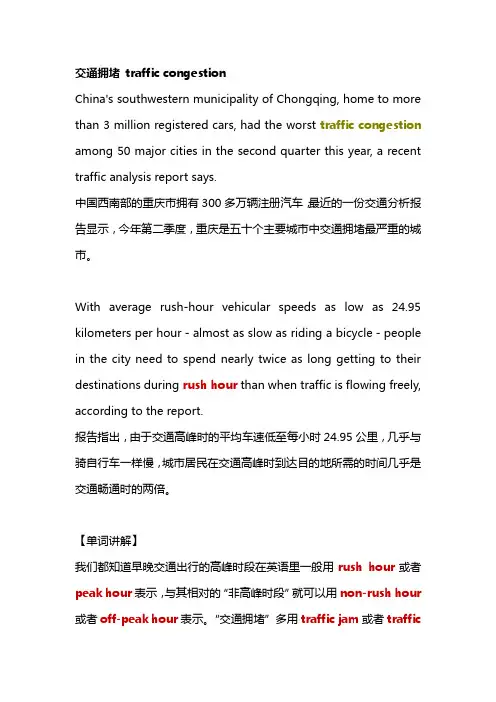
交通拥堵traffic congestionChina's southwestern municipality of Chongqing, home to more than 3 million registered cars, had the worst traffic congestion among 50 major cities in the second quarter this year, a recent traffic analysis report says.中国西南部的重庆市拥有300多万辆注册汽车,最近的一份交通分析报告显示,今年第二季度,重庆是五十个主要城市中交通拥堵最严重的城市。
With average rush-hour vehicular speeds as low as 24.95 kilometers per hour-almost as slow as riding a bicycle-people in the city need to spend nearly twice as long getting to their destinations during rush hour than when traffic is flowing freely, according to the report.报告指出,由于交通高峰时的平均车速低至每小时24.95公里,几乎与骑自行车一样慢,城市居民在交通高峰时到达目的地所需的时间几乎是交通畅通时的两倍。
【单词讲解】我们都知道早晚交通出行的高峰时段在英语里一般用rush hour或者peak hour表示,与其相对的“非高峰时段”就可以用non-rush hour 或者off-peak hour表示。
“交通拥堵”多用traffic jam或者trafficcongestion表示,jam比congestion的用法要多一些,因为jam还可以指我们平常吃的“果酱”。
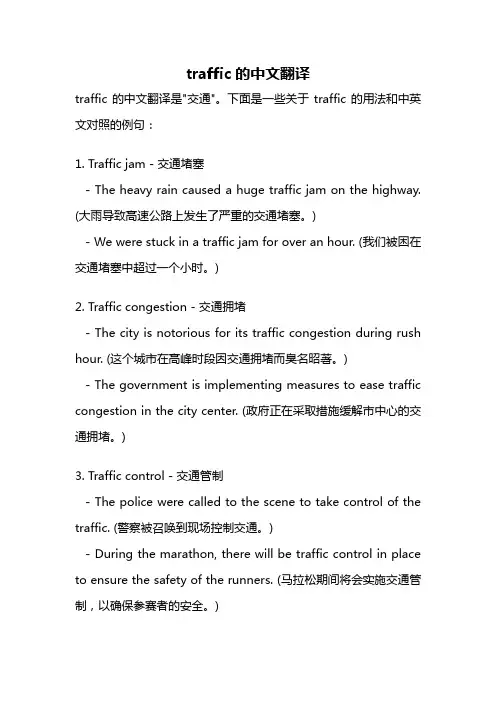
traffic的中文翻译traffic的中文翻译是"交通"。
下面是一些关于traffic的用法和中英文对照的例句:1. Traffic jam - 交通堵塞- The heavy rain caused a huge traffic jam on the highway. (大雨导致高速公路上发生了严重的交通堵塞。
)- We were stuck in a traffic jam for over an hour. (我们被困在交通堵塞中超过一个小时。
)2. Traffic congestion - 交通拥堵- The city is notorious for its traffic congestion during rush hour. (这个城市在高峰时段因交通拥堵而臭名昭著。
)- The government is implementing measures to ease traffic congestion in the city center. (政府正在采取措施缓解市中心的交通拥堵。
)3. Traffic control - 交通管制- The police were called to the scene to take control of the traffic. (警察被召唤到现场控制交通。
)- During the marathon, there will be traffic control in place to ensure the safety of the runners. (马拉松期间将会实施交通管制,以确保参赛者的安全。
)4. Traffic rules - 交通规则- It's important to follow traffic rules to avoid accidents. (遵守交通规则以避免事故是很重要的。
)- The driver was fined for not obeying the traffic rules. (这名司机因不遵守交通规则而被罚款。
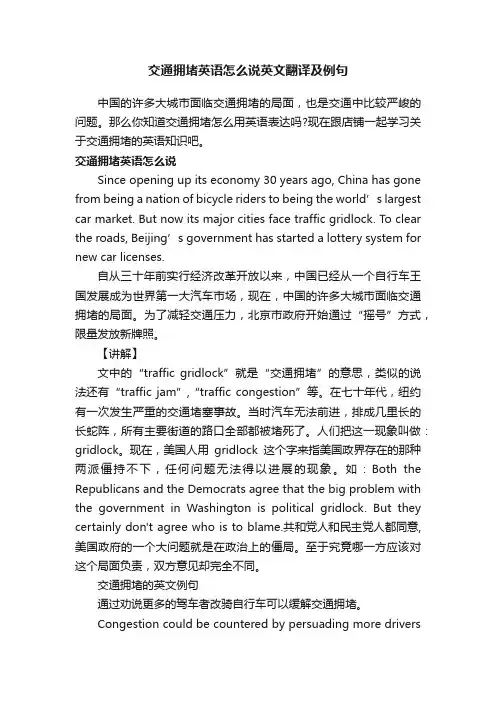
交通拥堵英语怎么说英文翻译及例句中国的许多大城市面临交通拥堵的局面,也是交通中比较严峻的问题。
那么你知道交通拥堵怎么用英语表达吗?现在跟店铺一起学习关于交通拥堵的英语知识吧。
交通拥堵英语怎么说Since opening up its economy 30 years ago, China has gone from being a nation of bicycle riders to being the world’s largest car market. But now its major cities face traffic gridlock. To clear the roads, Beijing’s government has started a lottery system for new car licenses.自从三十年前实行经济改革开放以来,中国已经从一个自行车王国发展成为世界第一大汽车市场,现在,中国的许多大城市面临交通拥堵的局面。
为了减轻交通压力,北京市政府开始通过“摇号”方式,限量发放新牌照。
【讲解】文中的“traffic gridlock”就是“交通拥堵”的意思,类似的说法还有“traffic jam”,“traffic congestion”等。
在七十年代,纽约有一次发生严重的交通堵塞事故。
当时汽车无法前进,排成几里长的长蛇阵,所有主要街道的路口全部都被堵死了。
人们把这一现象叫做:gridlock。
现在,美国人用gridlock这个字来指美国政界存在的那种两派僵持不下,任何问题无法得以进展的现象。
如:Both the Republicans and the Democrats agree that the big problem with the government in Washington is political gridlock. But they certainly don't agree who is to blame.共和党人和民主党人都同意,美国政府的一个大问题就是在政治上的僵局。
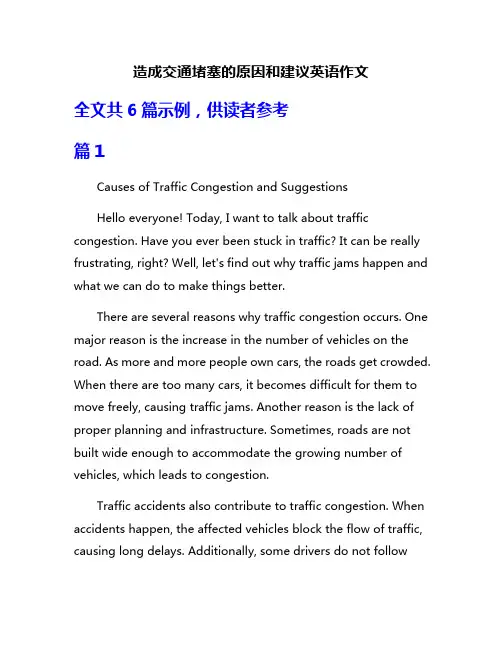
造成交通堵塞的原因和建议英语作文全文共6篇示例,供读者参考篇1Causes of Traffic Congestion and SuggestionsHello everyone! Today, I want to talk about traffic congestion. Have you ever been stuck in traffic? It can be really frustrating, right? Well, let's find out why traffic jams happen and what we can do to make things better.There are several reasons why traffic congestion occurs. One major reason is the increase in the number of vehicles on the road. As more and more people own cars, the roads get crowded. When there are too many cars, it becomes difficult for them to move freely, causing traffic jams. Another reason is the lack of proper planning and infrastructure. Sometimes, roads are not built wide enough to accommodate the growing number of vehicles, which leads to congestion.Traffic accidents also contribute to traffic congestion. When accidents happen, the affected vehicles block the flow of traffic, causing long delays. Additionally, some drivers do not followtraffic rules and drive recklessly. This can lead to accidents, which in turn cause traffic jams.Now that we understand some of the reasons behind traffic congestion, let's discuss some suggestions to improve the situation. One solution is to encourage people to use public transportation more often. If more people take buses or trains instead of driving their cars, there will be fewer vehicles on the road, and traffic congestion will decrease. Public transportation is also good for the environment because it reduces air pollution.Another suggestion is to promote carpooling. Carpooling means sharing a ride with others who are going in the same direction. By carpooling, we can reduce the number of cars on the road. It's not only a great way to make new friends but also helps to ease traffic congestion.Furthermore, we can encourage people to walk or ride bicycles for short distances. If the destination is nearby, it's better to use our legs or bicycles instead of cars. This not only helps reduce traffic congestion but also keeps us fit and healthy!In addition to these suggestions, the government can play a vital role in reducing traffic congestion. They can invest in improving public transportation systems and building better roads. By implementing traffic management strategies like trafficsignals, roundabouts, and one-way routes, they can ensure smooth traffic flow and reduce congestion.To conclude, traffic congestion happens due to the increase in the number of vehicles, lack of proper planning, accidents, and reckless driving. To alleviate this issue, we can encourage the use of public transportation, promote carpooling, and encourage walking or cycling for short distances. The government's support in improving infrastructure and implementing traffic management strategies is also crucial. By working together, we can make our roads less congested and our journeys smoother.Remember, even as young students, we can contribute to solving this problem by making wise transportation choices and spreading awareness about the importance of reducing traffic congestion. Let's take the first step towards a better future with less traffic jams!I hope you find this essay helpful. Good luck with your writing, and keep up the great work!篇2Causes of Traffic Congestion and SuggestionsHello, everyone! Today, I want to talk about something that affects many people every day: traffic congestion. Have you ever been stuck in traffic and wondered why the cars aren't moving? Well, let's find out the reasons behind traffic congestion and discuss some suggestions to solve this problem.There are several causes of traffic congestion. One major reason is the increase in the number of vehicles on the road. As more and more people own cars, the roads become crowded, especially during rush hours. This leads to slower traffic and longer travel times. Additionally, some drivers don't follow traffic rules properly, such as not using turn signals or cutting in front of others. These actions can cause accidents and traffic jams.Another reason for traffic congestion is road construction and repairs. While these activities are necessary to improve our roads, they can also disrupt the flow of traffic. When lanes are closed or detours are put in place, it slows down the movement of vehicles and creates bottlenecks. Sometimes, road construction projects take longer than expected, further aggravating the congestion problem.Furthermore, lack of proper public transportation options is also a contributing factor. Many people rely on their cars because there are not enough convenient buses or trainsavailable. When a large number of people drive their cars, it adds to the congestion on the roads. Encouraging the use of public transportation can help reduce traffic congestion and improve air quality.Now, let's discuss some suggestions to alleviate traffic congestion. First, we can promote carpooling or sharing rides with others. If more people travel together in one car, it means fewer cars on the road. This can help reduce traffic and make the journey faster for everyone. We can also encourage parents to organize walking or cycling groups for children who live nearby. Not only is it good for the environment, but it also reduces traffic around schools.In addition, investing in better public transportation systems can make a big difference. Governments should focus on improving bus and train services, making them more frequent and reliable. This will encourage more people to use public transportation instead of driving their cars. It would be great if there are dedicated bus lanes and bike lanes to make commuting easier and faster.Another suggestion is to educate drivers about the importance of following traffic rules and being considerate on the road. We can have campaigns and programs in schools toteach children about road safety and etiquette. When we grow up, we will become responsible drivers who respect others and help reduce traffic congestion.In conclusion, traffic congestion is a problem that affects many people. The increase in the number of vehicles, road construction, and lack of proper public transportation are the main causes of congestion. By promoting carpooling, improving public transportation, and educating drivers, we can all contribute to reducing traffic congestion and making our roads safer and smoother. Remember, even small actions can make a big difference. Let's all work together to solve this problem!I hope you found this essay helpful and informative. Let's raise awareness about traffic congestion and strive for a better future. Thank you!篇3The Big Traffic Jam ProblemHave you ever been stuck in a big traffic jam? It's the worst! You're just trying to get to school or soccer practice, and the cars around you aren't moving at all. After what feels like forever, you finally get to where you need to go, but you're already late. Ugh!Traffic jams happen when there are too many cars on the road at the same time, and they cause all kinds of problems. First, they make people late for important things like work, appointments, or picking up little brothers and sisters. Sitting in traffic is also really boring and frustrating. Nobody likes wasting time just sitting there doing nothing!But traffic jams don't just waste time – they also waste gas and cause air pollution that is bad for the environment. When cars are stuck not moving, they still have to keep their engines running. That burns up a lot of gas. And exhaust from all those idling cars releases gross fumes and smoke into the air that we have to breathe. Yuck!So what causes these big traffic jams in the first place? Well, there are a few different reasons:Too many cars on the road at once: This is probably the biggest cause. Think about it - if there's a road that can normally handle 100 cars easily, but 200 cars all try to use it at the same time, it's going to get crazy jammed up. Especially during rush hours when everyone is trying to get to work or home from work and school at the same times.Accidents: When there is a crash or disabled vehicle in the road, it blocks up some of the lanes. Then all the cars get backedup trying to squeeze into the remaining open lanes. That's how one little accident can cause a huge traffic jam that goes on for miles!Road work: Sometimes the roads themselves are a mess with construction zones for repairs, building new lanes, or fixing potholes and cracks. The workers have to block off or divert lanes to have room to work safely, and that squeezes the traffic flow even tighter through those zones.Bad weather: When it rains, snows, or there's fog or storms, roads get slippery and drivers have to slow way down to avoid skidding into accidents. That scrunches all the cars closer together and clogs things up. Rough weather can also knock down trees or power lines that block lanes too.Rubbernecking: Whenever there is some incident on the side of the road, like a small fender-bender or cops pulling someone over, other drivers always have to slow down to see what's going on. That creates a "rubbernecker's slowdown" that ripples backwards and causes backups.So those are some of the biggest reasons we end up with big traffic tie-ups. Now what can we do to try to reduce them?First, taking buses, trains, bikes or walking instead of driving a car helps reduce the total number of vehicles on the road. Cars take up a lot of space compared to buses that can move many more people through the same space. So using more public transportation and leaving the car at home would be a great start.Cities can also try to make their road systems smarter with programmable traffic lights and displays that adjust timing based on actual traffic patterns through the day. They could even have robots or drones that help clear stalled vehicles from the roads faster when accidents happen. Improving design to have more turns, dedicated lanes, overpasses and alternate routes would give drivers more options.Governments could encourage more people to useтелеработа (work from home) schedules at least a couple days per week. With fewer commuters on the roads, that would spread out the peaks of highest traffic volumes.Cities might want to look at having smarter schoolbuses that use computerized routing to pick up students in the most efficient sequence across neighborhoods too. That could cut down on the number of buses bunching up in certain areas.We can't snap our fingers and instantly fix all traffic everywhere. But if we all work together and our community leaders are smart about designing better transportation systems and behaviors, we can definitely start chipping away at those monster traffic jams. Then maybe we won't be late to so many important things anymore! What a dream that would be.篇4Causes of Traffic Congestion and SuggestionsHello everyone! Today, I would like to talk about a common problem that we all face in our daily lives – traffic congestion. Traffic congestion happens when there are too many vehicles on the road, making it difficult for cars, buses, and even bicycles to move smoothly. It can be frustrating and cause delays. Let's explore some of the reasons why traffic congestion occurs and what we can do to alleviate this problem.One of the main causes of traffic congestion is the increase in the number of vehicles on the road. As more people can afford cars and motorbikes, the roads become crowded. Imagine if all of us decided to travel to school in our own cars – the roads would be packed with vehicles, and it would take a long time to get to school! So, one solution is to encourage more people touse public transportation, such as buses or trains. Public transport can carry many people at once, reducing the number of vehicles on the road.Another reason for traffic congestion is the lack of proper road infrastructure. Sometimes, the roads are too narrow or poorly designed, causing bottlenecks and slowing down the traffic flow. To address this issue, the government can invest in building wider roads and adding more lanes. This would provide more space for vehicles to move freely and reduce congestion.Additionally, people not following traffic rules and regulations can contribute to traffic congestion. Some drivers may not obey traffic signals, change lanes without signaling, or park their cars in inappropriate places. These actions disrupt the smooth flow of traffic and lead to congestion. It is essential for everyone, including children, to learn and follow traffic rules. We can also raise awareness about the importance of obeying traffic regulations through campaigns and school programs.Another factor that contributes to traffic congestion is the lack of parking spaces. When people cannot find a parking spot, they may park their cars on the side of the road, blocking the traffic. To solve this problem, the government can build more parking lots and encourage people to use them. Furthermore,promoting the use of bicycles or walking for short distances can reduce the number of vehicles on the road, making traffic flow more smoothly.In conclusion, traffic congestion is a problem that affects all of us. It is caused by the increase in the number of vehicles, poor road infrastructure, violations of traffic rules, and insufficient parking spaces. To alleviate this issue, we can encourage the use of public transportation, improve road infrastructure, educate people about traffic rules, and provide more parking spaces. Let's work together to make our roads safer and less congested!Remember, even as students, we can contribute to reducing traffic congestion by being responsible road users and spreading awareness among our friends and family. Together, we can make a difference!I hope you found this article helpful, and I wish you all a smooth and congestion-free journey ahead. Thank you!篇5What Causes Traffic Jams and How Can We Fix Them?Traffic jams are the worst! They make you late for school, sports practice, or hanging out with friends. And they make yourparents stressed and grumpy when you're stuck in the car forever. I hate sitting in traffic, but I see it happening all the time on the roads near my house. Why does it happen so much? And what can we do to make it better? Let me tell you what I think!One of the biggest causes of traffic jams is too many cars on the road. Seems obvious, right? But it's true! The more cars that are driving around, the more likely you'll hit a jam. Especially if there is an accident or construction that blocks some of the lanes. With fewer lanes, all those cars get bunched together and can't go anywhere fast.My dad says a lot of those cars have just one person in them - the driver. He calls them "single occupancy vehicles." If more people carpooled or took buses and trains, there would be less traffic. Unfortunately, a lot of grown-ups seem to really like driving alone in their own cars. I don't get it - buses and trains seem way more fun to me since you can talk and play games with your friends!Another major cause is people driving too fast or too slow on the highway. If someone is going really slowly in the left lane meant for faster traffic, it backs everything up. Or if someone is zipping around going way too fast, they have to constantly hit the brakes for cars in front of them. That slam on the brakescauses a "shockwave" that slows down everyone behind them too. My dad yells a lot about people not using the correct lanes or going jerky speeds.Bad weather like ice, snow, rain, and fog also leads to way more traffic jams. When the roads are slick, everyone has to drive slower to avoid skidding into other cars. Sudden storms can make stuff pretty crazy on the roads too. One time we got caught in a huge thunderstorm on the highway and it seemed like everyone pulled over at the same time in a panicky traffic jam!Accidents are another obvious reason for jams. Even a small fender-bender can bring everything to a standstill on a busy road. That's because lots of rubberneckers will slow way down to try and see what happened. My mom calls them "hamptons" because they can't seem to help gawking at the accident. Pretty silly if you ask me!There are also just too many people on the road at certain times of day trying to get to work or school at the same time. My dad calls it "rush hour" but it lasts like 3 hours! Those jam-packed roads in the morning and evening cause a ton of delays. I always feel bad for my parents having to battle through that every day.So those are some of the main causes I've noticed for traffic jams. But what can we do to help reduce them? Here are some of my ideas:First, we gotta get more people to carpool, ride buses, take trains, walk, or bike instead of driving solo. Convince your parents to pick up a few kids from your neighborhood and rotate being the "carpool kid hauler." More people per car means fewer cars on the roads. You could even make a game out of it in the carpool van!Speaking of games, parents should play road games with their kids on trips to help avoid frustration in jams. The license plate game, I Spy, 20 Questions - those are all fun ways to pass delay times without going crazy. Bringing snacks, movies, and books can help too.City planners should try to have better coordinated street lights and smarter systems for keeping traffic moving smoothly. My third grade teacher said some cities have cameras and computers that can adjust lights to prevent unnecessary backups. Way smarter than just having lights change at fixed times!Maybe we should have highway lanes just for carpools, like a carpool incentive. Or a tax on solo drivers during peak jam timesto encourage carpooling. We could use that tax money to build better public transit systems too.And drivers for sure need to be more careful and follow the rules of the road better. Go the speed limit, use turn signals, don't tailgate, and stay out ofthe left lane unless you're passing someone. All that reckless driving just clogs things up.Construction crews should also try to minimize how many lanes get blocked during road work. Maybe they could rent truck-mounted traffic lights to cut down on backups. Or do more construction at night when the roads are emptier.Speaking of night work, maybe some companies could let employees work from home certain days to cut down on commuter traffic. I heard there are lots of people now who just video call into the office from their houses using laptops and stuff.Lastly, I think cities should invest in better public transportation like bullet trains between cities and neighborhoods. Having an awesome subway or monorail system would get so many people off the highways and roads. Imagine how less jammed it would be! Some of my friends in other countries say they can zoom around on high-speed trains instead of sitting in horrible traffic all the time.Well, those are my thoughts on why traffic seems so crazy these days and what we could possibly do to untangle it. I'm sure the grown-ups have some other good ideas too. But us kids are sick of being stuck in jams on the way to fun stuff! Hopefully, we can all figure out solutions to make our roads less con-jamed. Then maybe my parents will finally stop yelling at other drivers so much!篇6Traffic Congestion: Causes and SuggestionsHello everyone! Today, I want to talk about a big problem that many cities face - traffic congestion. Have you ever been stuck in traffic and felt like you were going nowhere? It can be really frustrating, right? Well, let's find out why traffic congestion happens and what we can do to make it better.There are several reasons why traffic congestion occurs. First, there are too many cars on the road. As more and more people own cars, the number of vehicles on the streets increases. This leads to crowded roads and traffic jams. Second, some drivers don't follow the traffic rules. They might park their cars in the wrong places or change lanes without signaling, which causes confusion and slows down the flow of traffic. Lastly, roadconstruction and accidents can also contribute to traffic congestion. When roads are blocked or closed, it creates bottlenecks and delays for everyone.Now that we know the causes, let's think about some solutions to reduce traffic congestion. One idea is to encourage people to use public transportation. Buses, trains, and subways can carry a lot of people at once, reducing the number of cars on the road. It would be great if more people could take the bus or train to school or work. Another solution is to promote walking and biking. If the distance is short, we can choose to walk or ride a bicycle instead of taking a car. This not only helps to reduce traffic but also keeps us healthy and active!In addition, carpooling is another effective way to alleviate traffic congestion. Instead of everyone driving their own car, friends, neighbors, or colleagues can share a ride together. This means fewer cars on the road, which leads to less congestion. Carpooling can also save money on gas and reduce air pollution. Isn't that amazing?Furthermore, we need to educate drivers about the importance of following traffic rules. It's crucial to park our cars in designated areas and obey traffic signs. When we all follow the rules, traffic flows more smoothly, and congestion can bereduced. We should also learn to be patient and polite on the road. Honking the horn or getting angry won't make the traffic move faster. Let's treat each other with kindness and respect.Lastly, city planners and government officials can play a significant role in reducing traffic congestion. They can invest in building more roads and improving existing ones. They can also create better public transportation systems with more buses and trains running frequently. Additionally, they can implement traffic management strategies like synchronized traffic lights to keep the traffic flowing smoothly.In conclusion, traffic congestion is a common problem in many cities. The causes include too many cars, drivers not following traffic rules, and road construction or accidents. To tackle this issue, we can encourage the use of public transportation, promote walking and biking, practice carpooling, educate drivers about traffic rules, and improve the infrastructure. Remember, even as young students, we can make a difference by making smart choices and spreading awareness about the importance of reducing traffic congestion. Let's work together to create a smoother and happier traffic experience for everyone!。
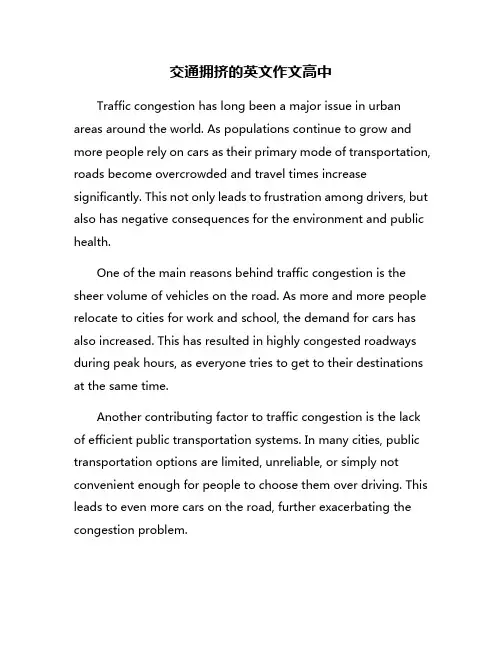
交通拥挤的英文作文高中Traffic congestion has long been a major issue in urban areas around the world. As populations continue to grow and more people rely on cars as their primary mode of transportation, roads become overcrowded and travel times increase significantly. This not only leads to frustration among drivers, but also has negative consequences for the environment and public health.One of the main reasons behind traffic congestion is the sheer volume of vehicles on the road. As more and more people relocate to cities for work and school, the demand for cars has also increased. This has resulted in highly congested roadways during peak hours, as everyone tries to get to their destinations at the same time.Another contributing factor to traffic congestion is the lack of efficient public transportation systems. In many cities, public transportation options are limited, unreliable, or simply not convenient enough for people to choose them over driving. This leads to even more cars on the road, further exacerbating the congestion problem.Furthermore, poor infrastructure planning and road design can also contribute to traffic congestion. In some cities, the layout of roads and intersections is inefficient, leading to bottlenecks and gridlock. Additionally, inadequate traffic management and lack of enforcement of traffic laws can worsen congestion by allowing for reckless driving and illegal parking.The impacts of traffic congestion are far-reaching and can have serious consequences for both individuals and society as a whole. For individuals, being stuck in traffic can lead to increased stress, frustration, and wasted time. Commuters may spend hours each week sitting in traffic, which can have a negative impact on their mental health and overall well-being. Additionally, traffic congestion can also lead to increased air pollution and greenhouse gas emissions, as cars sit idle in traffic jams releasing harmful pollutants into the atmosphere. This can have serious health consequences, particularly for vulnerable populations such as children, the elderly, and those with respiratory conditions.From a societal perspective, traffic congestion can have economic implications as well. Businesses may suffer as deliveries are delayed and employees are unable to get to work on time. Productivity can be negatively impacted, as workersspend more time commuting and less time actually working. Furthermore, the cost of maintaining roads and infrastructure to accommodate growing populations and increasing traffic volumes can be substantial, placing a strain on government budgets.In order to address the issue of traffic congestion, amulti-faceted approach is needed. Cities must invest in and improve public transportation systems to provide citizens with viable alternatives to driving. This can include expanding bus and rail networks, implementing bike-sharing programs, and promoting carpooling and ridesharing services. In addition, cities should focus on promoting sustainable transport modes such as walking and cycling, by creating safe and accessible infrastructure for pedestrians and cyclists.Moreover, cities need to prioritize smart urban planning and efficient traffic management strategies to alleviate congestion. This can include rethinking road layouts, optimizing traffic signal timings, and implementing congestion pricing schemes to reduce the number of vehicles on the road during peak hours. Infrastructure upgrades such as the construction of new roads, bridges, and tunnels can also help to improve traffic flow and ease congestion in heavily congested areas.Education and awareness campaigns can also play a role in reducing traffic congestion by encouraging individuals to make more sustainable transportation choices. By promoting the benefits of public transportation, walking, and cycling, cities can help shift behavior and reduce reliance on cars.In conclusion, traffic congestion is a serious issue that requires immediate attention and action. By investing in sustainable transportation options, improving infrastructure and traffic management, and promoting alternative modes of transport, cities can work towards alleviating congestion and creating a more livable and sustainable urban environment for all. It is imperative that governments, city planners, and individuals work together to find solutions to the problem of traffic congestion and create a more efficient andenvironmentally-friendly transportation system for the future.。
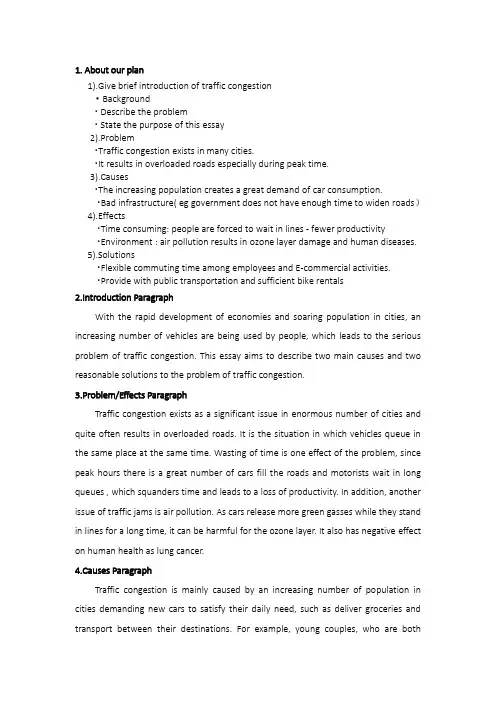
1. About our plan1).Give brief introduction of traffic congestion·Background·Describe the problem· State the purpose of this essay2).Problem·Traffic congestion exists in many cities.·It results in overloaded roads especially during peak time.3).Causes·The increasing population creates a great demand of car consumption.·Bad infrastructure( eg government does not have enough time to widen roads)4).Effects·Time consuming: people are forced to wait in lines - fewer productivity ·Environment: air pollution results in ozone layer damage and human diseases.5).Solutions·Flexible commuting time among employees and E-commercial activities.·Provide with public transportation and sufficient bike rentals2.Introduction ParagraphWith the rapid development of economies and soaring population in cities, an increasing number of vehicles are being used by people, which leads to theserious problem of traffic congestion. This essay aims to describe two main causes and two reasonable solutions to the problem of traffic congestion.3.Problem/Effects ParagraphTraffic congestion exists as a significant issue in enormous number of cities and quite often results in overloaded roads. It is the situation in which vehicles queue in the same place at the same time. Wasting of time is one effect of the problem, since peak hours there is a great number of cars fill the roads and motorists wait in long queues , which squanders time and leads to a loss of productivity. In addition, another issue of traffic jams is air pollution. As cars release more green gasses while they stand in lines for a long time, it can be harmful for the ozone layer. It also has negative effect on human health as lung cancer.4.Causes ParagraphTraffic congestion is mainly caused by an increasing number of population in cities demanding new cars to satisfy their daily need, such as deliver groceries and transport between their destinations. For example, young couples, who are both commuters and parents, need to commute to workplaces and drive their kids to schools. Another cause of traffic jams can be bad inadequate infrastructure which often occurs in developing countries. It is quite common to see that government does not have enough time to build sufficient roads or to replace the original old type of roads for more automobiles before the cityexpands dramatically. Automobiles have to travel on the narrow roads one after another, which results in irritate mass during peak time.5.Solution ParagraphOne solution to the problem of traffic congestion is to introduce flexible working time among some employees. Since they are the ones who commute to and from work during peak hours. If telecommuting and E-commercial employees are allowed to begin work at different time, this situation may decrease the number of vehicles on roads during rush hours. Also, companies can recommend their employees to accomplish their certain tasks at home, which can help them save time and be more efficient. The second solution is to emphasize the benefits of public transportation , which means up to 50 people can be assembled on a bus instead of 50 petrol-based cars crowded at the same place when rush hour emerges. Furthermore, in order to alter people’s means of transportation from driving private cars to bicycles, more communal bike rentals need to be set up by public sectors.6.Conclusion ParagraphIn conclusion, as the intense growth of population of cities and poor infrastructure of the transport systems, traffic congestion has become a significant issue around all over the world. This essay suggests that companies could introduce flexible working time among employees such as telecommuting and e-commercial, this means that employees are allowed to perform their activities from home instead of driving to their offices so they canavoid rush hours that leads traffic congestion. Another offer of this essay can be encourage of public transport use and more bicycle rental station, this can be a reasonable solution to the traffic congestion as well as pollution problem as this eco-friendly means would not produce toxic gases in the air.。
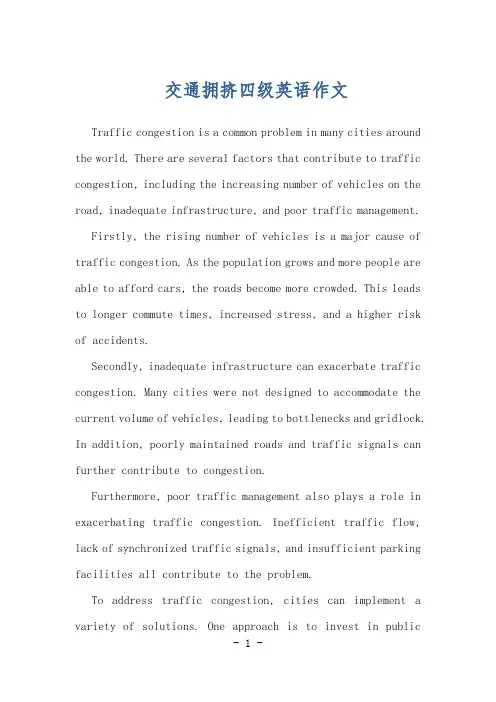
交通拥挤四级英语作文Traffic congestion is a common problem in many cities around the world. There are several factors that contribute to traffic congestion, including the increasing number of vehicles on the road, inadequate infrastructure, and poor traffic management.Firstly, the rising number of vehicles is a major cause of traffic congestion. As the population grows and more people are able to afford cars, the roads become more crowded. This leads to longer commute times, increased stress, and a higher risk of accidents.Secondly, inadequate infrastructure can exacerbate traffic congestion. Many cities were not designed to accommodate the current volume of vehicles, leading to bottlenecks and gridlock. In addition, poorly maintained roads and traffic signals can further contribute to congestion.Furthermore, poor traffic management also plays a role in exacerbating traffic congestion. Inefficient traffic flow, lack of synchronized traffic signals, and insufficient parking facilities all contribute to the problem.To address traffic congestion, cities can implement a variety of solutions. One approach is to invest in publictransportation systems, such as buses, subways, and light rail. By providing viable alternatives to driving, cities can reduce the number of vehicles on the road and alleviate congestion.Another solution is to improve infrastructure, such as building additional lanes, widening roads, and upgrading traffic signals. These improvements can help to improve traffic flow and reduce congestion.In addition, implementing smart traffic management systems, such as intelligent traffic lights and real-time traffic monitoring, can help to optimize traffic flow and reduce congestion.Finally, promoting alternative modes of transportation, such as walking, cycling, and carpooling, can also help to reduce the number of vehicles on the road and alleviate congestion.Overall, traffic congestion is a complex issue that requires a multifaceted approach to address. By investing in public transportation, improving infrastructure, implementing smart traffic management systems, and promoting alternative modes of transportation, cities can work towards reducing congestion and creating a more efficient and sustainable transportation system.交通拥挤是世界许多城市普遍存在的问题。
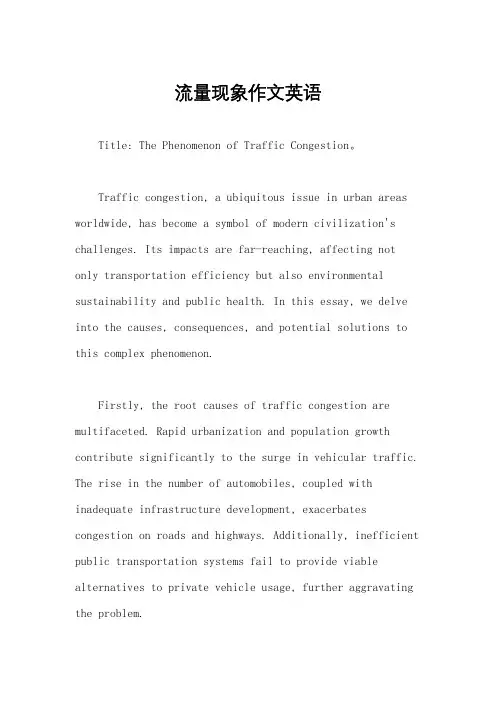
流量现象作文英语Title: The Phenomenon of Traffic Congestion。
Traffic congestion, a ubiquitous issue in urban areas worldwide, has become a symbol of modern civilization's challenges. Its impacts are far-reaching, affecting not only transportation efficiency but also environmental sustainability and public health. In this essay, we delve into the causes, consequences, and potential solutions to this complex phenomenon.Firstly, the root causes of traffic congestion are multifaceted. Rapid urbanization and population growth contribute significantly to the surge in vehicular traffic. The rise in the number of automobiles, coupled with inadequate infrastructure development, exacerbates congestion on roads and highways. Additionally, inefficient public transportation systems fail to provide viable alternatives to private vehicle usage, further aggravating the problem.Moreover, human behavior plays a crucial role in perpetuating traffic congestion. The phenomenon of "induced demand" suggests that building more roads or expanding existing ones often leads to an increase in traffic volume rather than alleviating congestion. This phenomenon highlights the psychological aspect of traffic behavior, wherein individuals adjust their travel patterns in response to changes in infrastructure.The consequences of traffic congestion are manifold and extend beyond mere inconvenience. Economically, congestion results in productivity losses due to increased travel time and fuel consumption. Businesses suffer from delayed shipments and reduced customer accessibility, leading to financial setbacks. Socially, congestion contributes to stress, frustration, and decreased quality of life for commuters. Furthermore, the environmental impact of traffic congestion cannot be overstated, with elevated levels ofair pollution and greenhouse gas emissions posing significant health risks and accelerating climate change.Addressing traffic congestion requires a comprehensive approach encompassing policy interventions, infrastructure improvements, and behavioral changes. Implementing congestion pricing schemes, such as toll roads or peak-hour charges, can effectively manage demand and encourage modal shifts towards public transportation. Investing in the expansion and enhancement of public transit networks, including buses, trains, and cycling infrastructure, is crucial to providing viable alternatives to car dependency.Furthermore, advancements in technology offer promising solutions to alleviate traffic congestion. Intelligent transportation systems (ITS), equipped with real-timetraffic monitoring and adaptive signal control, optimize traffic flow and reduce bottlenecks. Additionally, the emergence of ride-sharing and carpooling platforms facilitates the efficient utilization of existing vehicle capacity, thereby reducing the number of vehicles on the road.Education and awareness campaigns play a vital role in promoting sustainable transportation habits and fostering aculture of shared mobility. Encouraging telecommuting, flexible work schedules, and active transportation modes such as walking and cycling can significantly reduce the reliance on single-occupancy vehicles.In conclusion, traffic congestion represents a formidable challenge confronting modern society, with profound implications for mobility, economy, and the environment. Addressing this complex phenomenon necessitates a concerted effort involving government policies, infrastructure investments, technological innovations, and behavioral changes. By embracing sustainable transportation solutions and fostering a collective commitment to reducing car dependency, we can mitigate the adverse effects of congestion and pave the way towards a more efficient, equitable, and livable urban environment.。
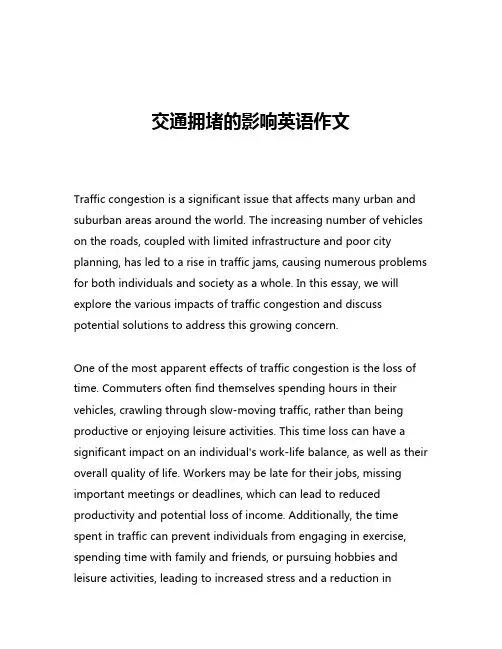
交通拥堵的影响英语作文Traffic congestion is a significant issue that affects many urban and suburban areas around the world. The increasing number of vehicles on the roads, coupled with limited infrastructure and poor city planning, has led to a rise in traffic jams, causing numerous problems for both individuals and society as a whole. In this essay, we will explore the various impacts of traffic congestion and discuss potential solutions to address this growing concern.One of the most apparent effects of traffic congestion is the loss of time. Commuters often find themselves spending hours in their vehicles, crawling through slow-moving traffic, rather than being productive or enjoying leisure activities. This time loss can have a significant impact on an individual's work-life balance, as well as their overall quality of life. Workers may be late for their jobs, missing important meetings or deadlines, which can lead to reduced productivity and potential loss of income. Additionally, the time spent in traffic can prevent individuals from engaging in exercise, spending time with family and friends, or pursuing hobbies and leisure activities, leading to increased stress and a reduction inoverall well-being.Another significant impact of traffic congestion is the financial burden it places on both individuals and society. The cost of fuel, vehicle maintenance, and insurance premiums can increase significantly due to the additional time and distance traveled in congested traffic. This financial strain can be particularly challenging for lower-income households, who may already be struggling to make ends meet. Moreover, the increased traffic congestion can lead to a slowdown in economic activity, as businesses may have difficulty delivering goods and services on time, and customers may be discouraged from visiting certain areas due to the difficulty of accessing them.Environmental concerns are also a major consequence of traffic congestion. The exhaust emissions from idling vehicles and the increased fuel consumption due to stop-and-go traffic contribute to air pollution, which can have devastating effects on public health and the environment. Exposure to high levels of air pollution has been linked to a range of respiratory and cardiovascular diseases, as well as increased risk of cancer and other health problems. Additionally, the greenhouse gas emissions from transportation contribute to climate change, which can have far-reaching and potentially catastrophic consequences for the planet.Traffic congestion can also impact public safety and emergency response times. When roads are heavily congested, it can be more difficult for emergency vehicles, such as ambulances and fire trucks, to reach their destinations quickly, potentially jeopardizing the lives of those in need of immediate assistance. Furthermore, the increased stress and frustration experienced by drivers in congested traffic can lead to aggressive driving behaviors, such as speeding, lane-changing, and tailgating, which can increase the risk of accidents and further exacerbate the congestion problem.To address the issue of traffic congestion, a multifaceted approach is required, involving both governmental and individual actions. Governments can invest in the expansion and improvement of public transportation systems, such as bus and rail networks, to provide commuters with alternative options to driving. Additionally, the implementation of congestion pricing, which charges drivers for using certain roads or entering certain areas during peak hours, can help to reduce the number of vehicles on the road and encourage the use of public transportation or carpooling.Urban planning and the development of more walkable and bikeable communities can also play a significant role in reducing traffic congestion. By designing cities with a focus on mixed-use development, where residential, commercial, and recreational areas are in close proximity, the need for long-distance commuting can bereduced. Furthermore, the incorporation of bike lanes and pedestrian-friendly infrastructure can encourage people to choose alternative modes of transportation, further easing the burden on the road network.Technological solutions, such as intelligent transportation systems and autonomous vehicles, also hold promise in addressing traffic congestion. Intelligent transportation systems can use real-time data and advanced algorithms to optimize traffic flow, reduce delays, and provide drivers with accurate information about traffic conditions. Meanwhile, the development of autonomous vehicles has the potential to improve traffic flow and reduce the risk of accidents, as these vehicles can communicate with each other and with the surrounding infrastructure to navigate roads more efficiently.Ultimately, addressing the issue of traffic congestion requires a collaborative effort from governments, urban planners, transportation authorities, and individual citizens. By implementing a combination of infrastructure improvements, policy changes, and technological advancements, we can work towards creating more sustainable and efficient transportation systems that benefit both individuals and the environment. While the challenge of traffic congestion is a significant one, with the right strategies and a commitment to addressing this problem, we can work towards afuture with smoother, safer, and more environmentally-friendly transportation.。
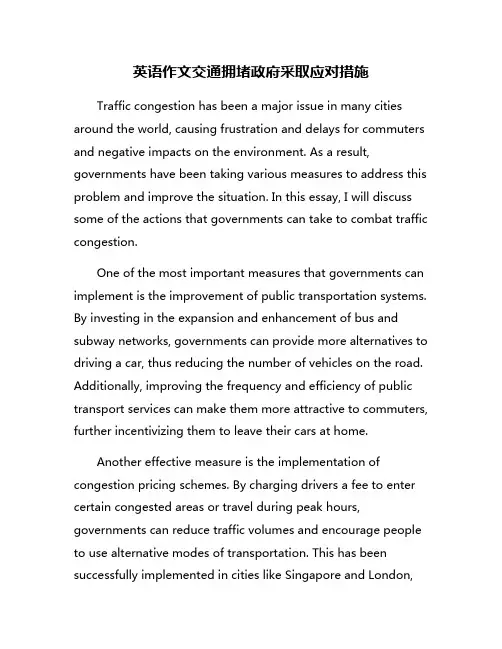
英语作文交通拥堵政府采取应对措施Traffic congestion has been a major issue in many cities around the world, causing frustration and delays for commuters and negative impacts on the environment. As a result, governments have been taking various measures to address this problem and improve the situation. In this essay, I will discuss some of the actions that governments can take to combat traffic congestion.One of the most important measures that governments can implement is the improvement of public transportation systems. By investing in the expansion and enhancement of bus and subway networks, governments can provide more alternatives to driving a car, thus reducing the number of vehicles on the road. Additionally, improving the frequency and efficiency of public transport services can make them more attractive to commuters, further incentivizing them to leave their cars at home.Another effective measure is the implementation of congestion pricing schemes. By charging drivers a fee to enter certain congested areas or travel during peak hours, governments can reduce traffic volumes and encourage people to use alternative modes of transportation. This has been successfully implemented in cities like Singapore and London,where traffic congestion has significantly decreased since the introduction of congestion pricing.In addition to these measures, governments can also promote carpooling and ridesharing as ways to reduce the number of vehicles on the road. By providing incentives such as HOV lanes and discounts on tolls for carpoolers, governments can encourage more people to share rides and reduce congestion. Furthermore, promoting cycling and walking as alternative modes of transportation can also help alleviate traffic congestion and improve air quality in cities.Furthermore, governments can invest in infrastructure projects to improve traffic flow and reduce congestion. This includes building new roads and highways, upgrading existing ones, and implementing intelligent transportation systems to better manage traffic flow. By investing in these projects, governments can enhance connectivity and reduce travel times, ultimately alleviating traffic congestion.Overall, addressing traffic congestion requires a multifaceted approach that involves improving public transportation, implementing congestion pricing schemes, promoting carpooling and ridesharing, investing in infrastructure projects, and encouraging alternative modes of transportation.By adopting these measures, governments can effectively reduce traffic congestion, improve air quality, and enhance the overall quality of life for residents in urban areas.。
交通拥堵的影响英语作文Traffic congestion has a significant impact on our daily lives. It affects not only our time but also our health, environment, and economy.Firstly, traffic congestion leads to wasted time and productivity. People spend a considerable amount of time stuck in traffic, which can lead to stress and frustration. This wasted time could have been used for more productive activities such as work, family time, or leisure activities. Moreover, traffic congestion also leads to increased fuel consumption and vehicle wear and tear, resulting in higher costs for individuals and businesses.Secondly, traffic congestion has a negative impact onour health. Prolonged exposure to traffic fumes can lead to respiratory problems and other health issues. The stressand frustration caused by traffic congestion can also havea detrimental effect on mental health. Furthermore, accidents are more likely to occur in congested traffic, leading to injuries and even fatalities.Additionally, traffic congestion contributes to environmental pollution. The emissions from idling vehicles and stop-and-go traffic contribute to air pollution and greenhouse gas emissions, which have a detrimental effect on the environment and contribute to climate change. This pollution can also have a negative impact on the local ecosystem and wildlife.Furthermore, traffic congestion has a significant economic impact. Businesses incur costs due to delayed deliveries and increased fuel expenses. Additionally, congestion can deter potential investors and businesses from establishing themselves in areas with chronic traffic problems, affecting local economies and employment opportunities.In conclusion, traffic congestion has wide-ranging and far-reaching effects on our daily lives. It not only impacts our time and productivity but also our health, environment, and economy. Addressing traffic congestion requires a multi-faceted approach that includes investment in public transportation, urban planning, and the promotion of alternative modes of transportation such as cycling andwalking. Only by addressing these issues can we mitigatethe negative impacts of traffic congestion and create more livable and sustainable cities.交通拥堵对我们的日常生活有着重大影响。
城乡交通拥堵英语作文Traffic congestion is a common problem in both urban and rural areas. In cities, the high volume of vehicles and limited road capacity often lead to traffic jams during rush hours. In rural areas, narrow roads and the lack of public transportation options can also cause congestion, especially during peak travel times.In urban areas, the main causes of traffic congestion include the high number of private vehicles on the road, inadequate public transportation infrastructure, and road construction or maintenance. In rural areas, the lack of alternative transportation options and the reliance on personal vehicles contribute to traffic congestion.The impacts of traffic congestion are far-reaching. It leads to wasted time and fuel, air pollution, increased stress for commuters, and a negative impact on the economy. In urban areas, it can also affect the efficiency of public transportation systems and emergency response times.To address traffic congestion, various measures can be taken. In urban areas, improving public transportationinfrastructure, implementing congestion pricing, and promoting carpooling and cycling can help reduce the number of vehicles on the road. In rural areas, investing in road infrastructure, expanding public transportation options,and promoting telecommuting can alleviate congestion.In conclusion, traffic congestion is a significant issue in both urban and rural areas, and it requires comprehensive solutions to address. By improving public transportation, promoting alternative modes of transportation, and investing in road infrastructure, wecan work towards reducing traffic congestion and creating a more efficient and sustainable transportation system.城乡交通拥堵是一个普遍存在的问题。
描述城市交通的拥堵状况英语作文Traffic Congestion in Urban Areas: A Growing Concern。
The rapid urbanization and economic development of modern cities have brought about a significant increase in the number of vehicles on the roads. As a result, traffic congestion has become a pervasive issue, causing a myriad of problems for both individuals and the community as a whole. The impact of this growing problem is far-reaching, affecting daily commutes, the environment, and the overall quality of life in urban areas.One of the primary factors contributing to the worsening traffic congestion is the sheer volume of vehicles on the roads. As the population in urban centers continues to expand, the demand for personal transportation has skyrocketed. Many individuals opt for private vehicles as their preferred mode of transportation, often due to the convenience and flexibility they offer. However, this surge in the number of cars has led to a significant strain on the existing infrastructure, with roads and highways struggling to accommodate the increasing traffic.Moreover, the problem is exacerbated by the limited availability of public transportation options in many cities. While some urban areas have invested in the development of efficient and reliable public transit systems, such as buses, trains, and subways, the coverage and accessibility of these services are often inadequate, leaving a significant portion of the population reliant on private vehicles. This, in turn, adds to the congestion on the roads, as more cars compete for the limited space.Another contributing factor to the traffic congestion crisis is the inefficient design and layout of many urban areas. Many cities were not originally planned with the current level of vehicular traffic in mind, leading to a road network that is ill-equipped to handle the demands of modern transportation. Poorly designed intersections, lack of dedicated turning lanes, and insufficient parking facilities all contribute to the overall gridlock experienced by commuters.The consequences of this traffic congestion are far-reaching and detrimental to both individuals and the community as a whole. One of the most immediate and tangible impacts is the increased travel time for commuters. Lengthy delays and slow-moving traffic can significantly impact the daily routines and productivity of individuals, as they spend more time in their vehicles and less time engaged in other activities. This, in turn, can lead to increased stress, frustration, and a reduced quality of life for those affected.Furthermore, the environmental impact of traffic congestion cannot be overlooked. The prolonged idling of vehicles and the stop-and-go nature of congested traffic result in higher fuel consumption and increased emissions of greenhouse gases and other pollutants. This has a direct impact on air quality, contributing to the deterioration of the local environment and potentially posing health risks to the surrounding population.The economic consequences of traffic congestion are also significant. The lost productivity and wasted time spent in traffic can have a detrimental effect on businesses and the local economy. Delays in the transportation of goods and services can lead to increased costs and reduced efficiency, ultimately impacting the overall competitiveness of the region.In response to this growing problem, many cities have implemented various strategies and initiatives to address the issue of traffic congestion. These efforts range from infrastructure improvements, such as the construction of new roads, highways, and public transportation systems, to the implementation of traffic management policies, including congestion pricing, high-occupancy vehicle (HOV) lanes, and the promotion of alternative modes of transportation, such as cycling and walking.While these measures have had some success in mitigating the problem, the challenge of traffic congestion remains a persistent and complex issue that requires a comprehensive and multifaceted approach. Effective solutions will likely involve a combination of infrastructure investments, policy changes, and behavioral modifications, all aimed at reducing the reliance on private vehicles and promoting more sustainable and efficient modes of transportation.In conclusion, the problem of traffic congestion in urban areas is a growing concern that requires immediate attention and concerted efforts from both policymakers and the public. By addressing the underlying causes and implementing a range of solutions, cities can work towards reducing the negative impacts of congestion and creating more livable, sustainable, and efficient urban environments for all.。
造成交通堵塞的主要原因英语作文Causes of Traffic JamsTraffic congestion is a common problem in many cities around the world. There are several factors that contribute to the occurrence of traffic jams, and it is important to understand these causes in order to find effective solutions to alleviate the problem. In this essay, we will discuss some of the main reasons behind traffic congestion.One of the primary causes of traffic jams is the sheer volume of vehicles on the road. As urban populations continue to grow, the number of cars on the road has also increased significantly. This leads to overcrowding on the roads, especially during peak hours, when people are commuting to and from work. The high density of vehicles results in slow-moving traffic and long queues at traffic lights and intersections.Another major factor contributing to traffic congestion is road infrastructure and layout. Many cities were not originally designed to accommodate the high volumes of traffic they experience today. As a result, roads are often narrow and winding, with inadequate space for vehicles to maneuver. Thiscan lead to bottlenecks and choke points, where traffic quickly becomes backed up and gridlocked.In addition, the lack of effective public transportation options can also contribute to traffic jams. In cities where public transportation is unreliable or inefficient, more people opt to drive their own cars, further exacerbating congestion. Furthermore, the absence of dedicated lanes for buses and bicycles can slow down traffic flow and create additional obstacles for drivers.Another common cause of traffic congestion is accidents and breakdowns. When vehicles collide or break down on the road, it can create a major disruption to traffic flow. Emergency responders and tow trucks must be called to the scene, leading to lane closures and further delays for motorists. In some cases, accidents can result in road closures or detours, causing even more severe congestion.Traffic signal timing and coordination also play a role in causing traffic jams. Poorly synchronized traffic lights can create stop-and-go conditions on major thoroughfares, leading to increased travel times and frustration for drivers. Inefficient signaling can also result in long queues and congestion at intersections, especially during rush hours.Lastly, construction and road maintenance projects can contribute to traffic congestion. When roads are closed or reduced to fewer lanes due to construction work, it can disrupt the flow of traffic and create bottlenecks. Although these projects are necessary for the upkeep and improvement of infrastructure, they can cause temporary inconveniences for drivers.In conclusion, traffic congestion is a complex issue with multiple contributing factors. By addressing the causes discussed in this essay, cities can work towards developing comprehensive solutions to alleviate traffic jams and improve the overall efficiency of their transportation systems. Whether through investment in public transportation, infrastructure improvements, or better traffic management strategies, it is essential for urban planners and policymakers to take proactive measures to tackle the problem of traffic congestion head-on.。
交通拥挤四级英语作文In recent years, China's cities have witnessed a significant increase in traffic congestion. With the rapid urbanization and economic development, the number of vehicles on the road has skyrocketed, leading to a series of problems related to traffic congestion.Causes of Traffic Congestion:1.Rapid Urbanization and Population Growth: As more and more people migrate tocities, the demand for transportation has increased dramatically. This has resulted in a surge in the number of vehicles, which in turn has caused traffic congestion.2.Insufficient Infrastructure: Despite the expansion of road networks, the infrastructure isoften inadequate to meet the growing demand. Narrow roads, limited publictransportation options, and a lack of parking facilities all contribute to traffic congestion.3.Unreasonable Traffic Management: Improper traffic management, such as insufficienttraffic signals, unclear road markings, and inadequate enforcement of traffic rules, can also lead to traffic congestion.Impacts of Traffic Congestion:1.Increased Travel Time and Cost: Traffic congestion significantly increases travel timeand cost, affecting the efficiency of individuals and businesses.2.Adverse Impact on Environment: The frequent stop-and-go driving caused by trafficcongestion leads to increased fuel consumption and emissions, posing a threat to theenvironment.3.Adverse Impact on Health: Long hours spent in traffic congestion can lead to stress,anxiety, and other health issues.Solutions to Traffic Congestion:1.Improving Infrastructure: Building more and wider roads, improving publictransportation options, and providing adequate parking facilities can help reduce traffic congestion.2.Optimizing Traffic Management: Implementing intelligent traffic systems, increasingthe number of traffic signals, and enforcing traffic rules strictly can improve traffic flow.3.Encouraging Alternative Modes of Transportation: Promoting cycling, walking, andthe use of electric vehicles can reduce the number of vehicles on the road and alleviate traffic congestion.Conclusion:Traffic congestion is a complex issue that requires comprehensive solutions.By improving infrastructure, optimizing traffic management, and encouraging alternative modes of transportation, we can effectively reduce traffic congestion and create a more efficient and sustainable transportation system.。
▁▂▃▄▅▆▇█▉▊▋▌精诚凝聚 =^_^= 成就梦想▁▂▃▄▅▆▇█▉▊▋▌大城市交通拥挤探因(The Causes of Traffic CongesUon in Big CiTraffic congestion has long been a problem of great concern and complaint in big cities. It has caused a lot of inconvenience to people‘s life and work. For example, people have to set off well in advance to get to work on time and come back very late when their work is over.There are many causes for this problem, but the following may be the most important ones. The first cause is the great increase in the number of private cars. Cars take up more space but they carry fewer people. Some private car drivers, ignoring traffic regulations, drive only for the sake of their own convenience, blocking the way of other public transportation vehicles. The second cause is the slow and inefficient construction and improvement of the roads and streets. With a large population and numbers of automobiles increasing, some roads still remain unimproved, which will surely lead to problems. The last cause is the insufficient management of the traffic system and the people‘s lack of awareness of traffic regulations.Many pedestrians cross the streets even when the traffic lights are against them, which is an obstacle to the flow of traffic. The problem of traffic congestion is an urgent one because it concerns the safety allofus. Wewillnot resolve it if we only rely on the government. Let all of us act now to solve it.▃▄▅▆▇██■▓点亮心灯 ~~~///(^v^)\\\~~~ 照亮人生▃▄▅▆▇██■▓。